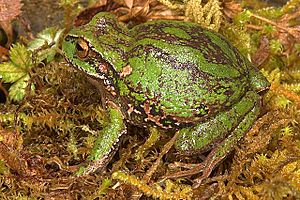Gastrotheca excubitor facts for kids
Quick facts for kids Gastrotheca excubitor |
|
|---|---|
 |
|
| Conservation status | |
| Scientific classification |
The Gastrotheca excubitor is a special kind of frog that belongs to the family Hemiphractidae. It is found only in southern Peru, living on the Amazonian slopes and high parts of the Cordillera Oriental mountains in the Cusco Region. Some people call it the Abra Acanacu marsupial frog. Scientists think there might be other similar frog species that look almost the same but are actually different, which they call cryptic species.
Contents
What Does It Look Like?
Adult male frogs are about 21 to 40 millimeters (0.8 to 1.6 inches) long from their snout to their rear. Female frogs are a bit bigger, measuring 33 to 41 millimeters (1.3 to 1.6 inches).
This frog has a rounded snout. It has an ear-like part called a tympanum that is shaped like an oval. The skin on its back is smooth.
The frog's back can be tan, gray, or green. It often has dark brown or green patterns. These patterns include a wide bar between its eyes, connected to two long stripes. Sometimes these stripes join together. The sides of its body can be bronze-tan to bluish-green with dark brown or cream spots. Its belly is tan. The iris (the colored part of its eye) is copper with thin black lines. When male frogs call, their vocal sac (a pouch under their chin that inflates) is dark gray.
How Does It Reproduce?
Female Gastrotheca excubitor frogs have a special pouch, like a kangaroo, on their back. This is called a brood pouch. They carry their eggs inside this pouch until the eggs hatch into tiny froglets. On average, a female frog carries about 20 eggs in her pouch.
Where Does It Live and How Is It Protected?
The Gastrotheca excubitor is a terrestrial frog, meaning it lives on land. It prefers humid Puna grassland areas, which are high-altitude grasslands with moss and tall grasses. These areas are usually above the treeline, at elevations from 3,080 to 4,080 meters (10,100 to 13,400 feet) above sea level. You can also find them in areas where there is some farming, but not too much.
During the day, these frogs typically hide under stones. At night, they might be seen walking around in deep moss. Male frogs call out at night to attract mates.
This frog species faces threats to its home. Its habitat is shrinking because of farming, burning of grasslands, and new buildings for tourism. A fungus called Batrachochytrium dendrobatidis has been found in these frogs, but it seems they are strong enough to resist it.
Good news is that Gastrotheca excubitor lives in several protected areas. These include the famous Manú National Park and the Machu Picchu Historical Sanctuary, which help keep their homes safe.
See also

- In Spanish: Gastrotheca excubitor para niños
Images for kids



